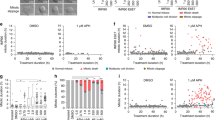Abstract
Following prolonged mitotic spindle disruption by microtubule poisons, mammalian cells delay their entry into anaphase, then progressively slip out of mitosis and become tetraploid. Normal cells then stop cycling before S-phase onset, but the mechanisms underlying this arrest are still unclear. Here we show that a double block prevents endo-reduplication. First, cells that exit mitosis without a functional microtubule network are driven toward G0. Reconstitution of the network unmasks a second block that relies on DNA double-strand breaks occurring early in the G1 phase that follows the mitotic block. We propose that a stress signal elicited upon mitotic impairment triggers breakage, which couples the leaky spindle checkpoint to the stringent DNA damage response. Consistent with this finding, cells defective for the damage response continue cycling and acquire, within a single cell cycle, both chromosome rearrangements and abnormal chromosome numbers that remarkably mimic the complex genetic hallmark of tumorigenesis.
This is a preview of subscription content, access via your institution
Access options
Subscribe to this journal
Receive 50 print issues and online access
$259.00 per year
only $5.18 per issue
Buy this article
- Purchase on Springer Link
- Instant access to full article PDF
Prices may be subject to local taxes which are calculated during checkout




Similar content being viewed by others
References
Aardema MJ, Albertini S, Arni P, Henderson LM, Kirsch-Volders M, Mackay JM et al. (1998). Mutat Res 410: 3–79.
Anglana M, Debatisse M . (2001). J Biol Chem 276: 36639–36646.
Bharadwaj R, Yu H . (2004). Oncogene 23: 2016–2027.
Casenghi M, Mangiacasale R, Tuynder M, Caillet-Fauquet P, Elhajouji A, Lavia P et al. (1999). Exp Cell Res 250: 339–350.
Ciciarello M, Mangiacasale R, Casenghi M, Zaira Limongi M, D'Angelo M, Soddu S et al. (2001). J Biol Chem 276: 19205–19213.
Coquelle A, Pipiras E, Toledo F, Buttin G, Debatisse M . (1997). Cell 89: 215–225.
Denko NC, Giaccia AJ, Stringer JR, Stambrook PJ . (1994). Proc Natl Acad Sci USA 91: 5124–5128.
Dutrillaux B . (1995). Adv Cancer Res 67: 59–82.
Felsher DW, Bishop JM . (1999). Proc Natl Acad Sci USA 96: 3940–3944.
Halappanavar SS, Shah GM . (2004). Cell Cycle 3: 335–342.
Hartwell LH, Kastan MB . (1994). Science 266: 1821–1828.
Jallepalli PV, Lengauer C . (2001). Nat Rev Cancer 1: 109–117.
Jimenez GS, Khan SH, Stommel JM, Wahl GM . (1999). Oncogene 18: 7656–7665.
Khan SH, Wahl GM . (1998). Cancer Res 58: 396–401.
Khan SH, Moritsugu J, Wahl GM . (2000). Proc Natl Acad Sci USA 97: 3266–3271.
Kops GJ, Weaver BA, Cleveland DW . (2005). Nat Rev Cancer 5: 773–785.
Mantel CR, Gelfano VM, Kim YJ, McDaniel A, Lee Y, Boswell HS et al. (2002). Cell Cycle 1: 327–336.
Margolis RL, Lohez OD, Andreassen PR . (2003). J Cell Biochem 88: 673–683.
Martin SS, Vuori K . (2004). Biochim Biophys Acta 1692: 145–157.
Masuda A, Takahashi T . (2002). Oncogene 21: 6884–6897.
Pusapati RV, Rounbehler RJ, Hong S, Powers JT, Yan M, Kiguchi K et al. (2006). Proc Natl Acad Sci USA 103: 1446–1451.
Rieder CL, Maiato H . (2004). Dev Cell 7: 637–651.
Rogakou EP, Pilch DR, Orr AH, Ivanova VS, Bonner WM . (1998). J Biol Chem 273: 5858–5868.
Stewart ZA, Leach SD, Pietenpol JA . (1999). Mol Cell Biol 19: 205–215.
Stubblefield E . (1964). Symp Intern Soc Cell Biol 3: 223–248.
Toledo F, LeRoscouet D, Buttin G, Debatisse M . (1992). EMBO J 11: 2665–2673.
Tritarelli A, Oricchio E, Ciciarello M, Mangiacasale R, Palena A, Lavia P et al. (2004). Mol Biol Cell 4: 3751–3757.
Tsuiki H, Nitta M, Tada M, Inagaki M, Ushio Y, Saya H . (2001). Oncogene 20: 420–429.
Uetake Y, Sluder G . (2004). J Cell Biol 165: 609–615.
Vafa O, Wade M, Kern S, Beeche M, Pandita TK, Hampton GM et al. (2002). Mol Cell 9: 1031–1044.
Wong C, Stearns T . (2005). BMC Cell Biol 6: 6.
Acknowledgements
This work was supported by the Association pour la Recherche sur le Cancer (ARC) and the Fondation pour la Recherche Médicale. L R was a Fellow of the French government (M E N R T) then of the ARC.
Author information
Authors and Affiliations
Corresponding author
Additional information
Supplementary Information accompanies the paper on the Oncogene website (http://www.nature.com/onc).
Supplementary information
Rights and permissions
About this article
Cite this article
Quignon, F., Rozier, L., Lachages, AM. et al. Sustained mitotic block elicits DNA breaks: one-step alteration of ploidy and chromosome integrity in mammalian cells. Oncogene 26, 165–172 (2007). https://doi.org/10.1038/sj.onc.1209787
Received:
Revised:
Accepted:
Published:
Issue Date:
DOI: https://doi.org/10.1038/sj.onc.1209787
Keywords
This article is cited by
-
Analysis of a rare progeria variant of Barrier-to-autointegration factor in Drosophila connects centromere function to tissue homeostasis
Cellular and Molecular Life Sciences (2023)
-
Imbalance of the spindle-assembly checkpoint promotes spindle poison-mediated cytotoxicity with distinct kinetics
Cell Death & Disease (2019)
-
The responses of cancer cells to PLK1 inhibitors reveal a novel protective role for p53 in maintaining centrosome separation
Scientific Reports (2017)
-
A simplified Bcl-2 network model reveals quantitative determinants of cell-to-cell variation in sensitivity to anti-mitotic chemotherapeutics
Scientific Reports (2016)
-
Aneuploidy generates proteotoxic stress and DNA damage concurrently with p53-mediated post-mitotic apoptosis in SAC-impaired cells
Nature Communications (2015)



